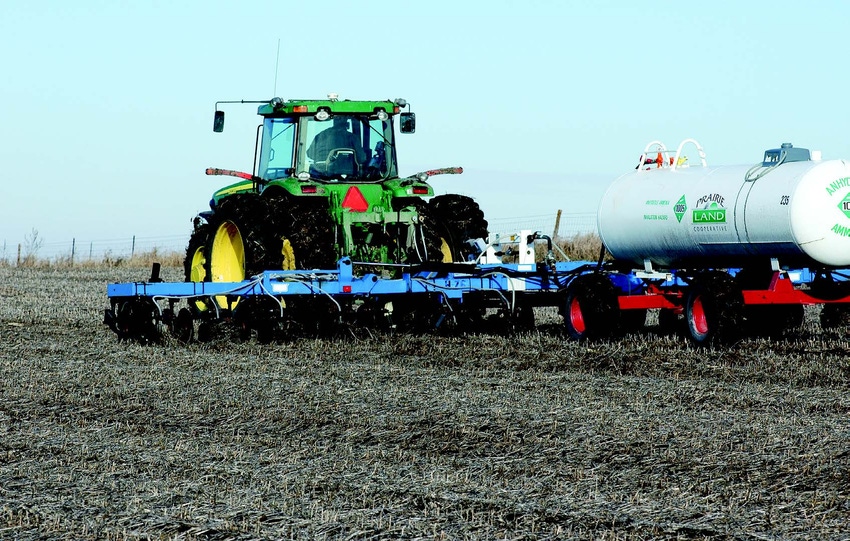
Think differentOver the past decade or more, Denny Friest and thousands of Iowa farmers have turned their yield monitors into a powerful research tool through the Iowa Soybean Association’s On-Farm Network.“The program gives farmers tools to conduct scientifically valid studies on their own farms,” says Peter Kyveryga, analytics operations manager for the On-Farm Network.Participating farmers work with researchers to design practical trials. Farmers across the state often conduct trials on similar topics, such as N fertilizer or fungicide performance, which enhances results’ reliability.Currently, groups in other states have developed, or are considering, their own on-farm research programs. Similar programs include the Indiana On-Farm Network and The Adapt Network, a joint project of Purdue University, Cornell University, the University of Connecticut and the Environmental Defense Fund.
February 25, 2014

Denny Friest’s goal is to manage his farm based on solid science.
So when the Iowa Soybean Association (ISA) started a program to use sophisticated software, yield monitors and other precision-ag tools to enable farmers to conduct scientifically valid research on their own farms in 2000, he jumped head first into the program.
“I would get to see how something works on my farm, on my soils, using my farming practices,” says Friest, Radcliffe, Iowa. “I knew if I could conduct replicated trials on my farm I could make better decisions.”
He’s conducted dozens of trials since 2000, and takes on several new comparisons each year. Here’s Friest’s take at the top five things he’s learned from his on-farm research trials.
1. Improved N management
When Friest began side-by-side N trials in the early days of the program, he typically applied 180 pounds of N on corn following soybeans, with a 200 bushel- per acre yield goal. Based on what he’s learned in trials over the years, his typical N application rate has fallen to 100 to 120 pounds per acre.
“On average, I am applying at least 50 pounds less N and getting the same or better yields,” says Friest. “I am interested in maximizing net profit per acre by using the most economic fertilizer rate – and being a better environmentalist.”
While reducing average N rates, he’s also added a sidedress program to reduce the risk of crops running short of the vital nutrient. “If we get a lot of rain in the spring, which can increase nitrogen losses, I side-dress up to 50 pounds per acre,” he says.
2. Best corn-on-corn tillage program
Friest’s philosophy on tillage is that less is better – as long as yields hold up. That’s why he conducted a continuous-corn tillage trial several years ago.
He compared no-till to disc-ripped and moldboard-plowed strips, which showed a strong advantage for more tillage. Disc-ripped strips out-yielded no-till by 15 bushels per acre. The moldboard plow system added another 8 bushels per acre above disc-ripping.
Friest has settled on disc-ripping as his system of choice. “The extra cost of fuel and time with moldboard plowing did not make practical sense,” he says.
“The biggest thing we are dealing with isn’t tillage, it is residue management,” adds Friest, who notes that removing crop residue to supply a nearby cellulosic ethanol plant may enable him to reassess corn-on-corn tillage practices in the future. “Managing residue is key in getting a good corn stand. My corn following beans has no fall tillage.”
3. Fungicides’ value
Trials on continuous corn have convinced Friest that fungicides generally pay off in second- and third-year corn, though not as likely in corn rotated from soybeans.
Fungal diseases seem to be higher on corn following corn, he says. “I have had instances of yield increases of 13-15 bushels per acre or more,” he says. “The return varies from hybrid to hybrid, but on average I expect 3-4 bushels per acre in extra yield from fungicides for $13/acre. The program probably won’t be quite as attractive with $4 corn.”
4. Soil insecticide pay-off
Soil insecticides have added 5 bushels per acre in the On-Farm Network the past two years, in continuous cornfields planted to Dekalb Genuity SmartStax and Pioneer Herculex Xtra rootworm hybrids. Earlier trials with single-trait rootworm hybrids also showed economic returns in some fields, says Friest.
“Trials over the past two years were on second- and third-year corn and the beetle pressure was very high,” says Friest. “You could see right to the row where the stalks were lodged, and the roots weren’t as healthy where insecticides weren’t applied.”
Aerial imagery captured as part of the trial showed numerous hot spots with especially high rootworm damage. Based on these trials, Friest plans to apply soil insecticides on continuous corn planted to rootworm hybrids in 2014. He also plans to rotate more fields to soybeans in hopes of reducing rootworm pressure in following years.
5. Best planting populations
Friest has conducted trials to identify the best seeding rates for corn and soybeans on his farm. He’s found that higher corn plant populations above his standard 33,000 seeding rate don’t produce enough extra yield to pay for the extra seed. He’s also learned that he can reduce soybean seeding rates below 140,000 seeds/acre without hampering yield, although he maintains that seeding rate to guard against potential losses from seedling damage.
In his most recent corn-population study, Friest compared 32,000 and 37,000 seeds per acre planting rates. In all of his trials, he’s not seen enough yield to cover the extra seed, he says.
Despite those results, Friest will continue to examine seeding rates as genetic companies introduce hybrids designed for higher populations. He’s added a new variable-rate planter for 2014, and will use On-Farm Network trials to evaluate its performance.
These trials have been very valuable in identifying which products and practices really work on his farm, Friest says.
About the Author(s)
You May Also Like





